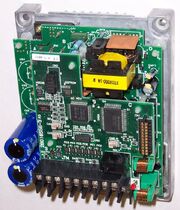
An industrial digital controller
Digital electronics or digital (electronic) circuits are electronics that handle digital signals (discrete bands of analog levels) rather than by continuous ranges as used in analog electronics. All levels within a band of values represent the same information state. Because of this discretization, relatively small changes to the analog signal levels due to manufacturing tolerance, signal attenuation or noise do not leave the discrete envelope, and as a result are ignored by signal state sensing circuitry.
In most cases, the number of these states is two, and they are represented by two voltage bands: one near a reference value (typically termed as "ground" or zero volts), and the other a value near the supply voltage. These correspond to the false and true values of the Boolean domain respectively. Digital techniques are useful because it is easier to get an electronic device to switch into one of a number of known states than to accurately reproduce a continuous range of values.
Digital electronic circuits are usually made from large assemblies of logic gates, simple electronic representations of Boolean logic functions.[1]
History[]
The binary number system dates back to the ancient Chinese I Ching. The binary number system was later refined by Gottfried Wilhelm Leibniz (published in 1705), influenced by the ancient I Ching's binary system.[2][3] Leibniz established that, by using the binary system, the principles of arithmetic and logic could be combined. Digital logic as we know it was the brain-child of George Boole, in the mid 19th century.
From 1934 to 1936, NEC engineer Akira Nakashima introduced switching circuit theory in a series of papers showing that two-valued Boolean algebra, which he discovered independently, can describe the operation of switching circuits.[4][5][6][7] Switching circuit theory provided the mathematical foundations and tools for digital system design in almost all areas of modern technology.[7]
See also[]
- Boolean algebra
- Combinational logic
- De Morgan's laws
- Formal verification
- Hardware description language
- Integrated circuit
- Logical effort
- Logic family
- Logic gate
- Logic minimization
- Logic simulation
- Microelectronics
- Ringing
- Sequential logic
- Switching circuit theory
- Transparent latch
- Unconventional computing
Notes[]
- ↑ Null, Linda; Lobur, Julia (2006). The essentials of computer organization and architecture. Jones & Bartlett Publishers. p. 121. ISBN 0-7637-3769-0. https://books.google.com.ar/books?id=QGPHAl9GE-IC&printsec=frontcover&dq=The+essentials+of+computer+organization+and+architecture#v=onepage&q&f=false. "We can build logic diagrams (which in turn lead to digital circuits) for any Boolean expression..."
- ↑ Nylan, Michael (2001). The Five "Confucian" Classics. Yale University Press. pp. 204–206. ISBN 978-0-300-08185-5. https://books.google.com/books?id=KykM1DhBxd8C&pg=PA206. Retrieved 8 June 2010.
- ↑ Perkins, Franklin. Leibniz and China: A Commerce of Light. Cambridge: Cambridge University Press, 2004. p 117. Print.
- ↑ History of Research on Switching Theory in Japan, IEEJ Transactions on Fundamentals and Materials, Vol. 124 (2004) No. 8, pp. 720-726, Institute of Electrical Engineers of Japan
- ↑ Switching Theory/Relay Circuit Network Theory/Theory of Logical Mathematics, IPSJ Computer Museum, Information Processing Society of Japan
- ↑ Radomir S. Stanković (University of Niš), Jaakko T. Astola (Tampere University of Technology), Mark G. Karpovsky (Boston University), Some Historical Remarks on Switching Theory, 2007, DOI 10.1.1.66.1248
- ↑ 7.0 7.1 Radomir S. Stanković, Jaakko Astola (2008), Reprints from the Early Days of Information Sciences: TICSP Series On the Contributions of Akira Nakashima to Switching Theory, TICSP Series #40, Tampere International Center for Signal Processing, Tampere University of Technology
References[]
- Douglas Lewin,Logical Design of Switching Circuits,Nelson,1974.
- R. H. Katz, Contemporary Logic Design, The Benjamin/Cummings Publishing Company, 1994.
- P. K. Lala, Practical Digital Logic Design and Testing, Prentice Hall, 1996.
- Y. K. Chan and S. Y. Lim, Progress In Electromagnetics Research B, Vol. 1, 269–290, 2008,"Synthetic Aperture Radar (SAR) Signal Generation, Faculty of Engineering & Technology, Multimedia University, Jalan Ayer Keroh Lama, Bukit Beruang, Melaka 75450, Malaysia